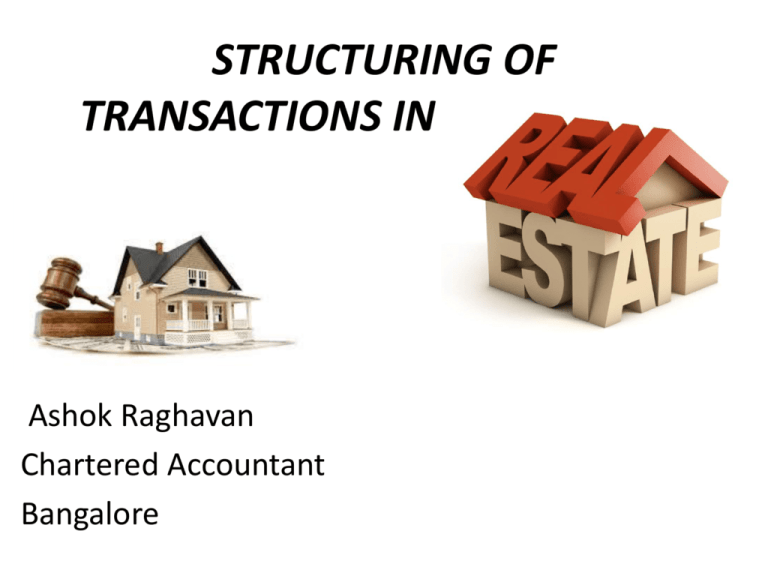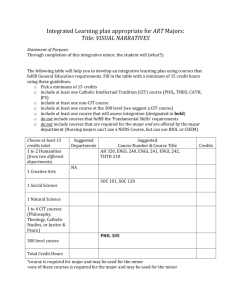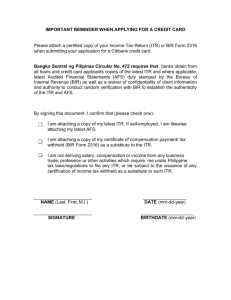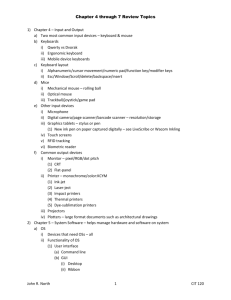tax issues relating to transactions in real estate
advertisement

STRUCTURING OF
TRANSACTIONS IN REAL ESTATE
Ashok Raghavan
Chartered Accountant
Bangalore
Critical definitions to be studied
Real Estate industry suffering
from the cascading effect of a
plethora of taxes.
Cost of material and services
will only go up
Only way to reduce cost is to
consumer is by minimizing tax
incidence.
Structuring is therefore
essential and rather a prerequisite.
Tax
Planning
1. Union of India and Another v.
Azadi Bachao Andolan and
Another 263 ITR 706 (SC)
2.Vodafone International Holdings
B.V. v. Union of India and Another
341 ITR 1 (2012) (SC).
3. Bhoruka Engineering Inds Ltd
Vs DCIT (2013) 356 ITR
25(Kar)
Definition of “Transfer” U/s 2(47)
Definition of “Immovable Property” U/s 269 UA (d) read with
section 2 (47)
Immovable property includes rights therein and benefits
arising there from.
Section 269UA(d) and Section 3(26) of the General Clauses
Act- TDR, Development Right etc.
Section 45 deals with transfer of a Capital Asset.
Taxable normally in the year of transfer with specific
exceptions such as Section 45 (1A), 45(2), 45 (5), etc…
SALE OF LAND AND BUILDING UNDER
COMPOSITE AGREEMENT
Composite Agreement for sale of land
and building
Land – Long Term and Building – Short Term
Bifurcation of consideration has to be made
CIT Vs Vimal Chand Golecha 201 ITR 442 (Raj)
CIT Vs DR.D.L.Ramachandra Rao 236 ITR 51 (Mad)
CIT Vs C.R. Subramanian(2000)242ITR 342(Kar)
INDIVIDUAL OR CO-OWNERS
CONTRIBUTING IMMOVABLE
PROPERTY INTO A FIRM AND THEN
ENTERING INTO DEVELOPMENT
• Partner contributing property as capital into the firm under
Section 14 of Partnership Act
• Value recorded in the books of the firm is deemed value of
consideration
• Firm to convert and treat the property as stock-in-trade in its
books
• Taxed as business income in the year in which property is sold
or otherwise transferred
• Joint Development to be entered into by firm after conversion
into stock-in-trade
• Specific wordings to be included in the development
agreement
• Applicability of Section 50C ?
TRANSFER OF PROPERTY THROUGH
RECONSTITUTION OF A FIRM
• Properties owned and held by the firms can
be transferred by reconstitution of the firm
• Rigors of the Schedule to the Stamp Act to be
noted
• Decision of Gurunath Talkies overruled by
recent decision of Dynamic Enterprises
• Decision of Sudhakar M Shetty (2011) (Mum
Tribunal) and Girija Reddy (Hyd Tribunal)
opens interesting tax planning opportunities
Distribution of properties owned and
held by a firm between the partners
Straight forward distribution of
assets between partners on
dissolution would have
implications u/s 45 (4)/ 43 CA of
the Income Tax Act
Firm to convert into an LLP under
Sec 55 r/w Second Schedule of
LLP Act
All properties of the firm vests
with the LLP- Refer Sec 58 (4)(b)
of LLP Act,
No stamp duty, no capital gainsRefer case laws under Part IX
STAGE-1
Balance Sheet of Partnership Firm AB
Enterprises
• LIABILITIES
A’s Capital
B’s Capital
Other Liabilities
13,50,000
13,50,000
3,00,000
• ASSETS
Immovable Prop-I 10,00,000
Immovable Prop-II 15,00,000
Other Assets
5,00,000
TOTAL
30,00,000
TOTAL
30,00,000
STAGE-2
Balance Sheet of the LLP-AB Enterprises
• LIABILITIES
A’s Capital
B’s Capital
Other Liabilities
• ASSETS
13,50,000 Immovable Prop-I 10,00,000
13,50,000 Immovable Prop-II 15,00,000
5,00,000
3,00,000 Other Assets
TOTAL
30,00,000 TOTAL
30,00,000
Contribute the immovable property of
the LLP as capital contribution to
different partnership firms
Shown in the illustrations as below-
A Estates (Partnership Firm)
• LIABILITIES
AB Enterprises-LLP
A’s Capital
C’s Capital
Other Liabilities
TOTAL
11,00,000
1,00,000
1,50,000
1,50,000
15,00,000
• ASSETS
Immovable Prop-I
Other Assets
Bank
TOTAL
10,00,000
2,50,000
2,50,000
15,00,000
B Estates (Partnership Firm)
• LIABILITIES
AB Enterprises-LLP
B’s Capital
D’s Capital
Other Liabilities
Total
• ASSETS
16,00,000 Immovable Prop-II
1,00,000 Other Assets
1,50,000 Bank
1,50,000
20,00,000 Total
15,00,000
2,50,000
2,50,000
20,00,000
STAGE-4
AB Enterprises -LLP
• LIABILITIES (in Rupees)
• ASSETS (in Rupees)
A’s Capital
B’s Capital
Share Capital in
A Estates
Share Capital in
B Estates
16,00,000
TOTAL
27,00,000
TOTAL
13,50,000
13,50,000
27,00,000
11,00,000
• Properties acquired through voluntary liquidation of the
company.
Can be used to unlock property from the company.
Title is passed by virtue of a deed of allotment through the order of the court.
No stamp duty payable on transfer of property {Madurai Mills (1973) 89ITR
45 as shareholder has pre-existing right.
Ideal where subsidiary Company’s assets has to be sold to redeem Holding
Company’s liabilities or where shareholder has losses in his business/es.
U/s 46(1) – there is no transfer in the hands of the Company
U/s 46(2) – Capital gain in the hands of share holder on market value less
deemed dividend U/s 2(22) (c)
Period of holding for shareholder –Refer Expn to Section 2(42A) r/w Section
49(iii)(c) of the Income Tax Act.
Capital Gains
in case of
slump sale
Definition u/s Slump Sale u/s
2(42C) and undertaking under
explanation to Section 2(19AA)
to be strictly adhered to.
Value Adopted for sale of
immovable
property
for
Registration Purpose does not
dilute definition of Slump Sale.
Period of Existence of the
division or undertaking is to be
reckoned
Values cannot be assigned to
individual assets except for
purposes of stamp duty in the
case of immovable property
Capital Gains in case of slump sale
Short term assets may get long
term benefit if they are part of
the
undertaking
being
transferred which is in
existence for more than 36
months.
No implications of VAT if
entire business of undertaking
is transferred as per rule
3(2)(g) of KVAT Rules 2005
and no Service Tax under
entry 25 of Mega exemption
notification dated 20-6-2012.
Interse gifts among relatives prior to
sale/ development transfer
Interse gifts to be made to
relatives to ensure spread of
exemption post transfer.
Each donee can invest in a
house property or bonds
under Section 54EC.
Clubbing provisions would
apply only on net income
after exemptions.
Ideal in the case of a small
joint development agreement.
Development of immovable property by a
person- conversion to stock in trade
In the case of an individual self
declaratory affidavit and change in books
of accounts.
In the case of a firm/LLP, change in deed
of partnership and disclosure in the books
of the firm.
In the case of company change in
Memorandum and Articles of Association
and disclosure in the books.
This treatment is ideal to postpone the
incidence of tax by applying provisions of
Section 45 (2)
This treatment is ideal before entering into
a joint development / revenue share
agreement.
Certain critical clauses to be inserted in
joint development agreement.
Refer observations in Ishikawajima’s case.
Transfer of immovable property in a
company
Acquisition in conventional route could involve higher taxation.
Acquisition through shares results in saving in stamp duty, saving
in capital gain for transferors.
Purchaser of shares unable to reflect value of property in his/ its
books.
Company could pay money for acquiring the brand or as an non
compete fee to the promoters to reduce the difference in
consideration being paid in excess of book value of shares.
Company contributing property into the firm at sale value.
Transferee becoming partners of the firm
Company (transferor) drawing the sale consideration introduced
as capital by transferee in the firm.
New firm carrying out development.
Ideal in cases where consideration is to be paid over a period of
time.
Point of conveying immovable
property critical post L&T judgment
VAT and service tax applicable throughout
construction phase.
VAT and service tax not applicable when
property is conveyed as immovable property
post completion without any advance
consideration for sale.
Lease cum sale model could be adopted for
acquisition of built to suit premises.
Observations of Ishikawajima relevant.
Tax Incidence on Development Agreement
Popularly known as “Joint Development”
Developer is empowered to act on owners’ behalf
No right or interest in the immovable property or right to have
possession of the property is conferred on the Developer in any manner
whatsoever .
Developer’s right to entry is only ‘license’ as understood u/s 52 of the
Indian Easements Act 1882..
Point of Tax Incidence
Tax Planning Possibilities
Transfer of property through Development Agreements.
A. Broad features of Development Agreement.
B. Main points relating to Taxation Highlighted.
C. Owner can convert the Lands into Stock-in-trade.
D. Recent judicial decisions under the Income Tax law and the decision of
L&T on works contract necessitates the need for new strategies.
E Possible incidence of Service Tax and VAT on Owners Share forces a
rethink on conventional development agreements
Decisions against:
Charturbuj Dwarakadas Kapadia Vs CIT (2003) 260 ITR 491 (Bom)
Jasbir Singh Sarkaria (2007) 294 ITR 196(AAR)-
CIT Vs Dr T K Dayalu (Karnataka HC) 202 Taxman 531 (Kar)
CIT Vs H B Jairaj ( Karnataka HC) - SLP Dismissed by SC.
Potla Nageswar Rao Vs DCIT (2014) 365 ITR 249 (AP).
Decisions favouring deferring of Capital Gains to the year of commencement of
development activity.
Fibars Infratech , Dilip Anand Vazirani etc.
Decisions in favour:
CIT Vs Attam Prakash & Sons 175 Taxman 499 (Del)
Naju Daru Deboo 218 Taxman 473 (All)
Vaswani Estates and Developers Vs State of Karnataka(Tribunal Decision under KVAT)
Refer wordings of Section 53A and 54 of the Transfer of Property Act,1882.
Obervations in the case of Highness Maharani Shantidevi P Gaikwad Vs Savjibhai
Haribhai Patel AIR 2001 (SC) 1462 (2001)- Agreement with developer does not create
an interest in property
Observations in the case of Govind Saran Ganga Saran v/s Commissioner of Sales Tax
and Others (1985) 155 ITR 145 (SC)
Observations in the case of Ishikawajima – Harima Heavy Industries Ltd. Vs Director of
Income Tax, Mumbai (2007) (SC) 288 ITR 408.
Amendment to Section 17 of the Indian Registration Act 1908
Owners can convert the lands into Stock-in-trade - To avoid incidence of capital gains at the
stage of signing the Development Agreement or at the point when the construction activity
commences, it is advisable for the Owners to convert the immovable property into stock in trade
either in the books of the proprietary concern of the Owner or by introducing the said
immovable property into a partnership firm as capital contribution and converting the said
property into stock in trade in the books of the firm.
•
R Gopinath (HUF) v. ACIT (2010) 5 Taxmann.com ITA Nos. 29 & 30/ MDS/2008 rendered by
the ITAT Chennai ‘A’ Bench on 24th July, 2009 also reported in 133 TTJ (Chennai) 595.
•
Ramesh Abaji Walavalkar v. Addln CIT 150 TTJ 725 Mum Trib. (D Bench)
•
Vidyavihar Containers Ltd v. Dy. CIT (2011) 133 ITD 363 (Mum. Trib)
•
DCIT vs Crest Hotels Ltd (2001) 78 ITD 231 (Chennai Bench).
•
Fardeen Khan Vs ACIT 11(1) Mumbai- ITA No 1588/1589 of 2013 rendered on 25-2-2015,
169 TTJ 398 ( ITAT F Bench Mumbai)
•
Dheeraj Amin Prop JV Builders Vs ACIT Circle 2(1) Mangalore, ITAT NO 1709/Bang/2013
rendered on 30-6-2015
Structure to be evolved
Formation of a Partnership firm between the
land Owner and the Developer.
Land owner to contribute immovable property as
capital contribution
Firm to pay 1% Registration Fee to enable entry into
Book I
Developer will become partner in the firm by
making initial capital contribution.
The profit sharing and drawings clause in the deed would be suitably
worded.
Owner will draw as profits a % of gross revenue less cost of land
contributed less proportionate income tax.
Developer to draw as profits a % of gross revenue less cost of
construction, selling cost, finance cost etc. less proportionate income
tax.
VAT, service tax & deposits for facilities would be retained by the firm
and paid accordingly.
Owners share of drawings will be transferred to a separate bank
account.
Dissolution clause in Deed to be drafted suitably
The firm will convert or treat the immovable property as stock in trade on the
happening of certain events
Advantages:
1)No need of POA to developer due to mutual agency in partnership
2)Question of giving a possession to the builder as a licensee or prospective
buyer does not arise
3) Incidence of Income tax postponed to the year of sale or transfer of stock
in trade
4) Recent judicial judgments on development agreements will not apply.
5) No VAT & Service Tax on Owners share being constructed by the Developer
Disadvantages:
Unlimited liability in partnership concept could affect the venture- mutual
indemnity to be given by owner and developer.
Property would be stuck in the firm in the event the development is abandoned
mid way and hence dissolution clause to be suitably worded.
Formation of LLP between the Owner and the Developer
LLP is a distinct legal entity registered under the LLP Act, 2008 but is
treated as a “firm” U/s 2(23) of the IT Act.
Advantages:
• Limited liability
• Mutual indemnity between owner and developer not required or
optional.
Disadvantages:
• Value of immovable property to be recorded in the books of LLP
should be in accordance with Sec 32(2) of the LLP Act r/w Sec 23 of
the LLP rules.
• Change in Karnataka Stamp Act with insertion of Article 40 A.
DEVELOPER TO BE TREATED AS A
CONTRACTOR
-Owner to retain legal title and possession of land till it is
transferred to the ultimate buyer.
- Construction Contract to be given to the builder for the
entire super built area allowed as per FSI.
- Builder to recover contractors fee by being entitled to sell
specified percentage of UDI in land and SBA.
- POA to be suitable worded to indicate agency coupled
with interest.
- VAT/ Service Tax to be collected in the name of the
Owner.
- Set off available on VAT/ Service Tax charged by the
builder on the Owner.
- Entire sales revenue minus contractor fee = Owners share
of revenue
- Contractors fee minus cost of construction = Developers
share of revenue
TAX INCIDENCE IN THE CASE OF REVENUE SHARING
AGREEMENTS/ARRANGEMENTS
• The Land Owner and Developer agree to share the "distributable revenue"
in a specified percentage.
• The Land Owner and the Developer join together in a tripartite agreement
with the ultimate purchaser of the apartment wherein the Land Owner
agrees to convey undivided right, title and interest in land to and in favour
of the prospective purchaser of apartments and the Developer agrees to
convey the specified super built up area being constructed on the land in
favour of ultimate purchaser of the apartments.
• A General Power of Attorney is executed by the Land Owners in favour of
the Developer giving him the powers to do all acts, deeds and things in
pursuance to the Revenue Sharing Agreement/Arrangement including the
power to sell the UDI in land in favour of the prospective purchasers.
• The agreement could be worded in a manner to indicate that the revenue
share accruing to the Land Owner is in essence only for the transfer of the
undivided share of right, title and interest in land and the revenue share of
the Developer is for transfer of specified super built up area.
• The insurable interest of the super built up area being constructed on the
land would be on the Developer during the period of construction and till the
date of its transfer.
• The legal ownership, domain and control of the land remains vested with the
Land Owner and no portion of it will be transferred to the Developer or his
nominees as the case maybe.
• There is no allocated area designated as Owner's share and Developer's share
as the case maybe.
• If the agreement is drafted keeping the above principles in mind, it can be
ensured that the Land Owner pays tax as " Business Profits" or as “Capital
Gains “ only at the point of transfer of risks and rewards of ownership in
favour of the transferees i.e., the purchaser of apartments, which event
would occur either at the point of execution of Sale Deed or handing over
possession of the apartment whichever is earlier.
• Further by entering into Revenue Sharing Agreement/Arrangement the
possibility of levy of VAT and Service Tax on the Owner's share of revenue
does not arise. Whereas, in the case of Joint Development Agreement based
on area share, there is a need for the Developer to levy VAT and Service Tax
on the Owner's share of super built up area.
Compensation Received for delay in delivery of Owner’s share
whether capital or revenue receipt?
i.
Guffic Chem (P) Ltd v. CIT (2011) 198 Taxmaan 78 (SC), 332 ITR
602 (SC)
ii. Gillanders Arbuthnot & Co Ltd v. CIT (1964) 53 ITR 283 (SC)
iii. CIT & Anr. v. Sapthagiri Distilleries Ltd (2014) 366 ITR 271 (Kar)
iv. CIT v. Spencers & Co Ltd (No.1) (2013) 359 ITR 612 (Mad)
v. G. Raveendran v. CIT (2015) 57 Taxmann.com 2014 (Mad)
Compounding fee r/w Explanation 1 to Section 37 – Not a
deductible expenditure
Explanation 1 to Section 37 : For the removal of doubts, it is hereby
declared that any expenditure incurred by an assessee for any
purpose which is an offence or which is prohibited by law shall not
be deemed to have been incurred for the purpose of business or
profession and no deduction or allowance shall be made in respect
of such expenditure.
Case Laws:
1. CIT Vs Mamta Enterprises (2004) 266 ITR 356 (Kar)
2. Nahar Spinning Mills Ltd V CIT Ludhiana(2014) 226 taxmann 364
(P & H )
3. Modi Builders Vs JCIT Range 5 Pune (2015) 60 Taxmann.com 54
(Pune Trib)
4. Maddi Venkataraman and Co Pvt Ltd (1988) 229 ITR 534 Para 534
(SC)
5. Millenia Developers Pvt Ltd Vs Dy.CIT (2010) 322 ITR 401(Kar)
Interest on borrowed capital- assessee engaged in
development of properties- Income from projects assessed
in year of completion- entire interest on borrowed capital is
allowed as deduction and is conformity of AS 7 issued by
the ICAI.
Joint CIT v. K. Raheja P. Ltd. [2007] 290 ITR (AT) 69 (Mumbai)
Cases Referred:
1. Calico Dyeing and Printing Works v. CIT [1958] 34 ITR 265 (Bom)
(para 16)
2. CIT v. Lokhandwala Construction Industries Ltd. [2003] 260 ITR
579 (Bom) (para 11, 13, 15, 16, 18)
3. CIT v. V.S. Dempo and Co. P. Ltd. [1996] 131 CTR 203 (Bom) (para
3)
4. India Cements Ltd. v. CIT [1996] 60 ITR 52 (SC) (para 16)
5. S.K. Estates P. Ltd. v. Asst. CIT [1997] 60 ITD 621 (Mum) (paras
3,4,6,9,10)
Amount collected by Developer from buyers towards Flat Owners
Association Corpus Fund is not an income in the hands of the
Developer.
Asst. CIT vs. Smt.C.Rajini (2011) 9 ITR (Trib) 487 (Chennai).
Assessee who is a Developer and not a contractor can declare the
revenue from the project as and when the risks and rewards of
ownership are transferred as per the principles laid down under
Accounting Standard 9 formulated by the ICAI.
1. Dy. CIT V Sudhir V Shetty (2014) 35 ITR (Trib) 115 (Mum “H” Tribunal)
2. S N Builders and Developers Vs ACIT 4(1) Bangalore ITA No
487/Bang/2013 rendered on 11-4-2014
3. Prestige Estate Projects Ltd V DCIT ITA 218/Bang/2009 (ITAT Bangalore)
4. CIT Vs Rema Country Holdings Pvt Ltd ITA No 1041 and 1042/2006
order dated 29-9-2011 (Kar HC)
Where a building complex has apartments exceeding
1500sq.ft, proportionate deduction should be allowed u/s
80IB (10) in respect of the Income relating to apartments
below 1500 sq.ft.
1. ACIT Vs Bengal Ambuja Housing Development Ltd (Kolkata-ITAT) 39-D
BCAJ 546
2. Sanghvi And Dishi Enterprise Vs Income Tax Officer (2011) 141 TTJ (Chn)
(TM) 1, Chennai ‘A’ Bench (Third Member Bench)
3. Sri Mahalakshmi Housing and Sri Mahalakshmi Builders Vs Income Tax
officer ITR (Trib) Vol 18 608 (Chn)
4. Brahma Associates v. JCIT 313 ITR (AR) 268 (Pune) (SB))
5. CIT v SJR Builders ITA No. 32 of 2010 dated 19.03.2012 (Kar HC)
6. DCIT vs. Brigade Enterprises (P) Ltd. 119 ITJ 269 (Bangalore –ITAT)
7. ITO v. Satyanarayan Ramswaroop Agarwal (2014) 163 TTJ (Pune ’A’-Trib)
17
8. Ramsukh Properties v. Dy.CIT (2013) 84 DTR (Pune) (Trib) 383
Ownership of land was not an essential condition to be
eligible for claiming deduction of income from construction
and development of residential housing project u/s 80IB
(10) of the IT Act, 1961.
1. Radhe Developers VS. ITO (Ahmedabad-ITAT) (2012) 341 ITR 403(Guj)
2. CIT v. Safal Associates (2014) 58 (I) ITCL 376 (Guj-HC) : 2014 TaxPub
(DT) 2405 (Guj-HC)
3. CIT v. Nikhil Associates (2014) 58 (I) ITCL 452 (Guj-HC), 45
taxmann.com 278 (Gujarat)
4. Nihil Associates v ITO (2011) 12 Taxmann.com 76 (Ahd- Trib) (URO)
5. CIT vs. Moon Star Developers 2014 TaxPub(DT) 2231 (Guj HC)
6. CIT vs. Mahalakshmi Housing 2014 TaxPub (DT) 1542 (Mad HC): (2014)
222 Taxman 356 (Mad).
7. Asst. CIT vs. Smt.C.Rajini (2011) 9 ITR (Trib) 487 (Chennai)
Amendment to Section 80IB(10), brought out by Finance Act, 2004
w.e.f 01.04.2005, whereby the definition of super built area was
changed to include projections and balconies and place a restriction
regarding maximum commercial area to be built-up by assessee within
the housing complex, for purposes of claiming deduction under said
section would apply only prospectively and not retrospectively.
1. Arun Excello Foundations (P.) Ltd. Vs. ACIT, (Chennai-ITAT) 166 Taxman 53
2. CIT and Another Vs G R Developers (2013)353 ITR 1(Kar).
3. CIT and Another V Anriya Project Management Services P Ltd (2013) 353 ITR 12
(Kar)
4. CIT Vs Brahma Associates (2011) 333 ITR 289( BOM)
5. Manan Corporation V ACIT (2013) 356 ITR 44(Guj)
6. CIT vs Happy Home Enterprises (2015) 372 ITR 1(Bom)
7. CIT Vs Sarkar Builders (2015) 375 ITR 392(SC)
The land on which the housing project is to be developed need not be vacant
as long as the housing project is on the land which exceeds one Acre.
CIT vs.Vandana Properties (2013) 353 ITR 36 (Bom HC)
Disallowance u/s 40(a)(ia) will not affect deduction u/s 80IB(10) as the
deduction is based on “Profits and Gains” derived from business.
Favour:
S. B. Builders & Developers v. ITO (2011) 39 (II) ITCL 548 (Mum ‘E’-Trib): (2011) 136
TTJ (Mum-Trib) 420: (2011) 45 SOT 335 (Mum-Trib)
Income Tax Officer, Ward-9(3), Pune v. Kalbhor Gawade Builders (2013) 141 ITD
612 (Pune ‘B’-Trib): (2013) 155 TTJ (Pune ‘B’-Trib) 124
Income Tax Officer v. Keval Construction (2013) 53 (I) ITCL 386 (Guj-HC)
Against:
Deputy Commissioner of Income Tax v. Rameshbhai C. Prajapati (2013) 49 (II) ITCL
250 (Ahd ‘C’-Trib): (2013) 23 ITR (Trib) 516 (Ahd ‘C’-Trib): (2013) 140 SOT 486
(Ahd ‘C’-Trib)
Deduction u/s 80IB- Computation- Interest received for delayed payment
of consideration
1.
CIT v. Suzlon Energy Ltd. (2013) 354 ITR 630 (Guj)
Followed by:
2.
Nirma Industries Ltd. v. Dy. CIT (2006) 283 ITR 402 (Guj)
Composite Housing scheme consists of six blocks in area exceeding one acre,
plan approved block wise, assessee entitled to deduction u/s 80 IB (10).
CIT Vs Voora Property Developers Pvt Ltd (2015) 373 ITR 317 (MAD)
Car parking area not to be included as part of permissible area for claiming
deduction U/s 80IB (10)
Asst. CIT Vs Smt Rajini and Dy CIT Vs C Subba Reddy, HUF (2011) 9 ITR (Trib) 487
(Chn).
Area of car park not included in built up area for deduction u/s 80 IB (10)
CIT Vs Subba Reddy (HUF) (2015) 373 ITR 103 (Mad)
Proportionate deduction available under section 80IB (10) in respect of
apartments not exceeding 1500 sq ft even though some apartments in the
same complex exceed 1500 sq ft.
Sanghvi & Doshi Enterprise v. ITO (2011) 141 TTJ (Chn) (TM) 1, Chennai ‘A’ Bench
(Third Member Bench)
ALV of flats, built by assessee engaged in construction business, lying unsold, is
assessable as Income from House Property
Case Laws:
1. CIT V/s Ansal Housing Finance and Leasing Co., Ltd 354 ITR 120 (Delhi), (2013)
Taxman 143 (Delhi)
2. CIT – 12 Mumbai V/s Sane and Doshi Enterprise (2015) 58 Taxmann.com (Bombay)
3. CIT V/s Discovery Estates (P) Ltd (2013) 31 Taxmann.Com 180 (Delhi)
No Capital gains on the transfer of TDR
There is no Capital gains on the transfer of TDR as there is no cost of acquisition to
acquire the TDR and in the absence of a specific provision to tax the same as provided
in other cases under Section 55.
Case Laws:
1. CIT -18 V/s Sambhaji Nagar Co-op Housing Society Ltd. ITA No. 1356 of 2012
rendered on 11/12/2014 (Bombay HC)
2. New Shailaja Co-op Housing Society Limited (2009) 121 TTJ 0062 (Mum Tribunal)
Practical Issues on TDS u/s 194IA : Construction Linked Finance:- In the above
arrangement the financer is acting purely for and on behalf of the transferee.
In such cases even though the payments are being made by the financer directly to the
transferor, the obligation to deduct Tax at Source under Section 194 IA or Section 194
C as the case may be, would be that of the transferee and not the financer.
It would therefore be necessary for all transferees to consider and adopt the following
optionsa) Instruct the financer to pay the agreed amounts to the transferor after reducing the
amount attributable to Tax Deducted at Source and pay the Tax Deducted at Source on
behalf of the transferee using the PAN of the Transferee directly to the Government in
the prescribed challan.
b) Instruct the financer to pay the amount attributable to Tax Deducted at Source to the
transferee for the onward remission of Tax Deducted at Source by the transferee.
c) Instruct the transferors to remit the Tax Deducted at Source by using the PAN of the
transferees on the prescribed challan in case they receive the entire amount from the
financers directly.
TDS to be deducted by the transferee in the case of Development
Agreements:
In case the deductor insists on deducting tax only on the Owner and not
the Developer the only option for the Owner and Developer would be to
take refuge under Rule 37BA of the IT Rules. The Owner shall have to file a
declaration as provided in the said rule with the deductee (Transferee) that
the Tax has be deducted at source on the Developer.
As a related issue, where the Owner is getting a specified super built area
in future in exchange for the undivided/divided share of land being
transferred to the Developer and/or his nominees in terms of the
Development Agreement, it would be rather prudent and advisable for the
Owners to adopt the view that there is a “transfer” as on the date of
entering into the development agreement as in that way, the credit for the
tax deducted at source by the Developer on the Owners Share can be taken
in the year when the income from Capital Gains is being offered by the
Owner. The Owner could for this purpose adopt the guideline value for the
land as permitted u/s 50D of the Income Tax Act as the “consideration”
for the purpose of transfer and instruct the Developer to deduct tax u/s
194 IA based on such consideration.
Double-taxation where there is transfer of Capital Asset from a person to
another who treats such asset as Stock in Trade.
It is to be noted that where an Individual or HUF acquires immovable
property to be retained and sold as stock in trade for a consideration which
is below the guideline value, he will be taxed on the difference as per the
provisions of Section 56(2)(vii) (b) and when such stock in trade is sold,
only the actual consideration paid is allowed to be deducted with no
provision to include the step up cost. This will amount to double taxation.
It is significant to note that the provisions of section 49(4) of the Income
Tax Act which provides for step up of cost to the transferee is applicable
only to transfers to which the provisions of section 56(2) (vii) and (vii a)
of the Income Tax Act are applicable, and is only for the purpose of
computing Capital Gains.
This hardship could be mitigated only with an identical provision such as
section 49(4) is inserted into Section 43CA of the Income Tax Act as well.
The taxation of the same income in the hands of two persons and also in
the hands of the same person under the Income Tax Act could be held to
be ultra virus Article 265 of the Constitution of India and also against the
well established principle enunciated by several judicial pronouncements.
CA Ashok Raghavan
Bengaluru







